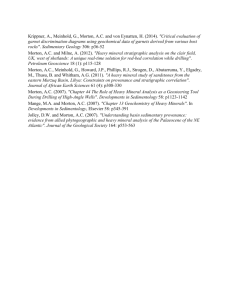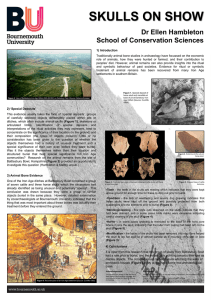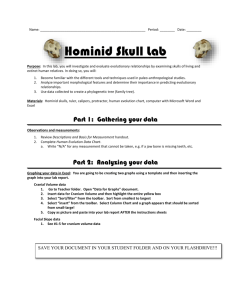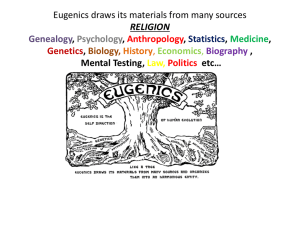Craniometry
advertisement
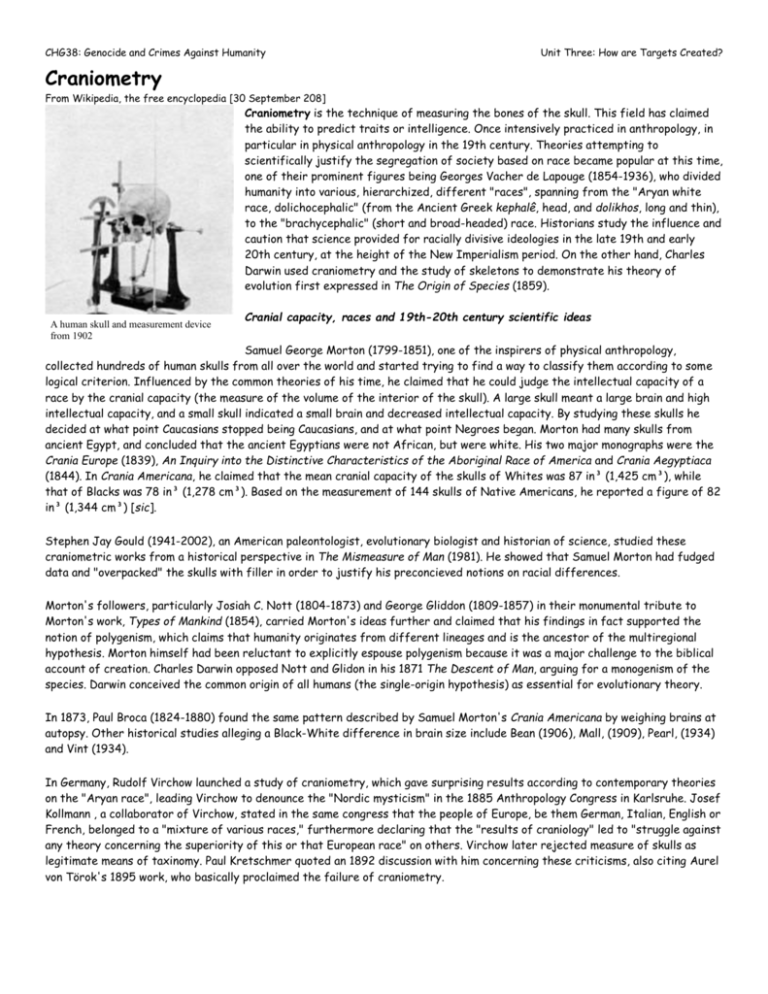
CHG38: Genocide and Crimes Against Humanity Unit Three: How are Targets Created? Craniometry From Wikipedia, the free encyclopedia [30 September 208] Craniometry is the technique of measuring the bones of the skull. This field has claimed the ability to predict traits or intelligence. Once intensively practiced in anthropology, in particular in physical anthropology in the 19th century. Theories attempting to scientifically justify the segregation of society based on race became popular at this time, one of their prominent figures being Georges Vacher de Lapouge (1854-1936), who divided humanity into various, hierarchized, different "races", spanning from the "Aryan white race, dolichocephalic" (from the Ancient Greek kephalê, head, and dolikhos, long and thin), to the "brachycephalic" (short and broad-headed) race. Historians study the influence and caution that science provided for racially divisive ideologies in the late 19th and early 20th century, at the height of the New Imperialism period. On the other hand, Charles Darwin used craniometry and the study of skeletons to demonstrate his theory of evolution first expressed in The Origin of Species (1859). A human skull and measurement device from 1902 Cranial capacity, races and 19th-20th century scientific ideas Samuel George Morton (1799-1851), one of the inspirers of physical anthropology, collected hundreds of human skulls from all over the world and started trying to find a way to classify them according to some logical criterion. Influenced by the common theories of his time, he claimed that he could judge the intellectual capacity of a race by the cranial capacity (the measure of the volume of the interior of the skull). A large skull meant a large brain and high intellectual capacity, and a small skull indicated a small brain and decreased intellectual capacity. By studying these skulls he decided at what point Caucasians stopped being Caucasians, and at what point Negroes began. Morton had many skulls from ancient Egypt, and concluded that the ancient Egyptians were not African, but were white. His two major monographs were the Crania Europe (1839), An Inquiry into the Distinctive Characteristics of the Aboriginal Race of America and Crania Aegyptiaca (1844). In Crania Americana, he claimed that the mean cranial capacity of the skulls of Whites was 87 in³ (1,425 cm³), while that of Blacks was 78 in³ (1,278 cm³). Based on the measurement of 144 skulls of Native Americans, he reported a figure of 82 in³ (1,344 cm³) [sic]. Stephen Jay Gould (1941-2002), an American paleontologist, evolutionary biologist and historian of science, studied these craniometric works from a historical perspective in The Mismeasure of Man (1981). He showed that Samuel Morton had fudged data and "overpacked" the skulls with filler in order to justify his preconcieved notions on racial differences. Morton's followers, particularly Josiah C. Nott (1804-1873) and George Gliddon (1809-1857) in their monumental tribute to Morton's work, Types of Mankind (1854), carried Morton's ideas further and claimed that his findings in fact supported the notion of polygenism, which claims that humanity originates from different lineages and is the ancestor of the multiregional hypothesis. Morton himself had been reluctant to explicitly espouse polygenism because it was a major challenge to the biblical account of creation. Charles Darwin opposed Nott and Glidon in his 1871 The Descent of Man, arguing for a monogenism of the species. Darwin conceived the common origin of all humans (the single-origin hypothesis) as essential for evolutionary theory. In 1873, Paul Broca (1824-1880) found the same pattern described by Samuel Morton's Crania Americana by weighing brains at autopsy. Other historical studies alleging a Black-White difference in brain size include Bean (1906), Mall, (1909), Pearl, (1934) and Vint (1934). In Germany, Rudolf Virchow launched a study of craniometry, which gave surprising results according to contemporary theories on the "Aryan race", leading Virchow to denounce the "Nordic mysticism" in the 1885 Anthropology Congress in Karlsruhe. Josef Kollmann , a collaborator of Virchow, stated in the same congress that the people of Europe, be them German, Italian, English or French, belonged to a "mixture of various races," furthermore declaring that the "results of craniology" led to "struggle against any theory concerning the superiority of this or that European race" on others. Virchow later rejected measure of skulls as legitimate means of taxinomy. Paul Kretschmer quoted an 1892 discussion with him concerning these criticisms, also citing Aurel von Törok's 1895 work, who basically proclaimed the failure of craniometry. Date: _______________________ CHG38: Genocide and Crimes Against Humanity Name: _______________________________ Unit Three: How are Targets Created? What was Craniometry? Read the article “Craniometry” from Wikipedia (see reverse) and complete the following: 1. What is craniometry and why did it become popular in the latter part of the 19thg Century? /2 2. How did craniometrist distinguish between the races? /2 3. According to Samuel George Morton, how could you expect to determine the intellect of a given race of people? /1 4. Of the three major groups of skulls he studied (European, African, and Native American), which did Morton suggest would be the most and least intelligent based on their respective size? /2 5. What was Stephen Jay Gould’s criticism of Morton’s findings? /2 6. What is polygenism, and what was its implication to race relations? /2 7. Moving beyond simple skull measurements, what did Broca add to the field of craniometry? Did Broca’s conclusions support or differ from previous suggestions that the white race was the most intelligent? /2 8. In the latter part of the 19th Century, what were the consequences of Virchow and Kollmann’s studies in regards to the generally accepted belief that craniometry proved the supremacy of an Aryan race? /2 Date: _______________________ CHG38: Genocide and Crimes Against Humanity Name: _______________________________ Unit Three: How are Targets Created? Knowledge: /15
